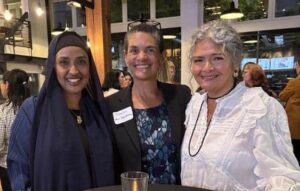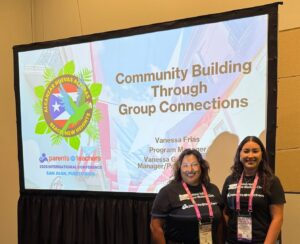Built around the themes of Affirming a Sense of Self and Kermit the Frog’s “It’s Not Easy Being Green” , a song that has become an anthem for embracing difference, especially for children and adults who feel marginalized or unsure of their place, the song’s message offers simplicity that makes it accessible, with emotional depth that gives it lasting power.
The day opened with a powerful Land and People Acknowledgment shared by Whitney Nakamura of United Way of King County, grounding participants in community and purpose. Planning for the event began in July, with new and returning committee members shaping a day that blended creativity, cultural connection, and practical tools.
Books, core to the ParentChild+ model, anchored each activity, with selections organized around themes of Love and Intention, Joy and Connection, Resilience and Self-Esteem, and Uniqueness and Pride. Many titles were sourced from First Book and offered in multiple languages, expanding access and inspiration for coordinators and families alike.

Dr. Nnenna Fanciamore, PhD, from the national ParentChild+ team, delivered a standout session titled “Demystifying Challenging Behaviors in Young Children.” Her ‘Connect before correct’ approach resonated deeply, offering practical, compassionate strategies for everyday family engagement.
Throughout the day, participants paused for guided reflection, led by State Director Pamela Williams and Marcella Taylor, Senior Program Manager for PC+, who encouraged thoughtful journaling using the event’s signature “green” notebooks and frog pens, a nod to the color’s ability to foster creativity and create a sense of psychological safety, “Green can signal openness and receptivity, making it a powerful color in spaces that aim to foster inclusion and belonging.”
The afternoon featured a joyful “Sing and Share” activity, where sites debuted original songs inspired by the day’s book themes, many performed in the diverse languages spoken across the network.
Another core goal of the day was to equip the team with tools to transfer their learning directly to the families they serve—bridging professional development with real-world impact. This intention was woven throughout the sessions, ensuring that every strategy, song, and insight could be adapted for home visits and family engagement. By centering practical application, the event affirmed the team’s role not just as learners, but as knowledge carriers and relationship builders.
The day closed on a high note, filled with energy, laughter, and heartfelt connection. Even after eight hours together, participants were still eager to share ideas, songs, and reflections—proof of the strong sense of community and purpose that defines ParentChild+. The event served as a celebration of the meaningful work happening across King County and a reminder of the joy that comes from learning, growing, and reflecting together.

 Meeting Urgent Needs in Times of Uncertainty
Meeting Urgent Needs in Times of Uncertainty Beyond the Immediate: Linking Direct Service and Systems Change
Beyond the Immediate: Linking Direct Service and Systems Change




 Start Early Washington’s Policy and Advocacy Associate Lauren Allen brings empathy, persistence, and purpose to their work advancing early learning across Washington State. From their earliest experience with advocacy to shaping policy supporting children and families, Lauren’s journey reflects the heart and humanity behind meaningful public service.
Start Early Washington’s Policy and Advocacy Associate Lauren Allen brings empathy, persistence, and purpose to their work advancing early learning across Washington State. From their earliest experience with advocacy to shaping policy supporting children and families, Lauren’s journey reflects the heart and humanity behind meaningful public service.